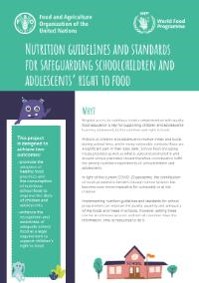The project aims to improve children’s diets, through the adoption of nutrition guidelines and standards within national school food programmes and policies, and through the promotion of effective food education strategies and complementary food environment interventions in school systems. The project is also focused on integrating such standards and complementary measures into national legal frameworks and promoting social control mechanisms, in order to support the right to food of schoolchildren and adolescents.
BACKGROUND
Every day, millions of children and adolescents consume foods during school hours, and in many vulnerable countries a school meal constitutes a significant part of their diet: it is therefore essential that the food available in schools responds to children’s nutrition priorities and is aligned with the possibilities of their local food systems.
Nutrition guidelines and standards (NGS) are rules, principles and recommendations designed to improve the nutritional quality and quantity, as well as the adequacy, of foods and meals in schools. NGS go beyond setting nutrient-based targets, and require specific processes to be effective, including the collection and analysis of individual food consumption data, the understanding of the value chain and procurement possibilities, the acknowledgement of regional and local consumption patterns, among others.
NGS therefore have the potential to support the right to food of these often-vulnerable groups; however, the necessary processes are resource-intensive, require technical capacities and involve the coordination of different sectors: many low- and middle-income countries cannot undertake this or have some nutrition criteria that need revision. To date, there are no clear processes to develop effective nutrition guidelines and standards and no internationally-recognized methodology to do so. This project is meant to address these gaps.
WHAT DOES THE PROJECT DO?
WHAT DOES THE PROJECT DO?
The project will construct a global methodology for developing cost-effective, feasible, participatory, context-specific and (food) systems-based nutrition guidelines and standards to ensure that school food is aligned to the nutrition, education and sociocultural needs of students. Aspects such as local availability, food-preparation infrastructure, social and cultural meaning of food will be considered in the model to facilitate its use in different food-system contexts.
Moreover, the project will develop additional tools and measures, such as food education interventions, food environment policies, and so on, that will complement the NGS to enhance their impact as well as their integration into national legal frameworks anchored in the Right to Food.
An online global knowledge hub has been set up within the context of the project to ensure that the methodology, guidance products and piloting experiences are widely available and reach target institutions and stakeholders. The hub also serves as a global repository for countries to share their own experiences, policies and legislative instruments related to school food NGS. It features a “Youth corner” to enhance participation and to give a voice to right bearers in such exchanges through stories, videos and case studies, and it will also provide an interactive platform for countries, organizations and existing networks to discuss and exchange.
The methodology will be piloted in Cambodia and Ghana at subnational level in collaboration with WFP and government stakeholders. Global and country-level capacity development, communication, advocacy and youth engagement strategies will further support and complement the results.
OBJECTIVES
The project aims to accomplish two mutually-reinforcing outcomes:
- Promote the adoption of healthy food practices and the consumption of school food to improve the diets of children and adolescents.
- Enhance the recognition and awareness of adequate school meals and food as legal requirements to realise children’s right to food.
The project has been designed to achieve five outputs:
- (Country-level) Nutrition guidelines and standards and complementary measures are developed, strengthened and applied, using a food systems approach, by pilot countries.
- (Country-level) Capacities to effectively design, implement, evaluate and revise NGS for school food and complementary measures are enhanced in pilot countries.
- (Global) A validated methodology and complementary tools for designing NGS for school food are available for use by target institutions in LMICs.
- (Global) The global dialogue around the need, priority and potential of systems-based NGS for school food is strengthened in LMICs.
- (Global and country) Guidance to incorporate NGS as a legal requirement to fulfil children’s and adolescents’ right to food is available for LMICs.



